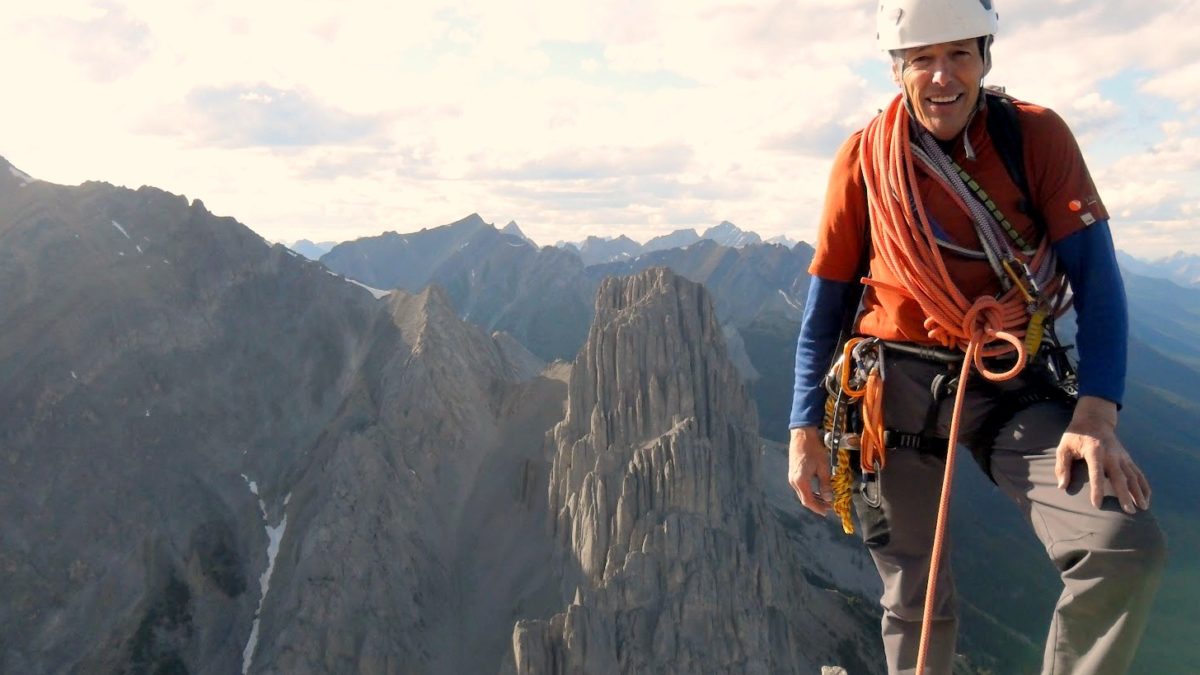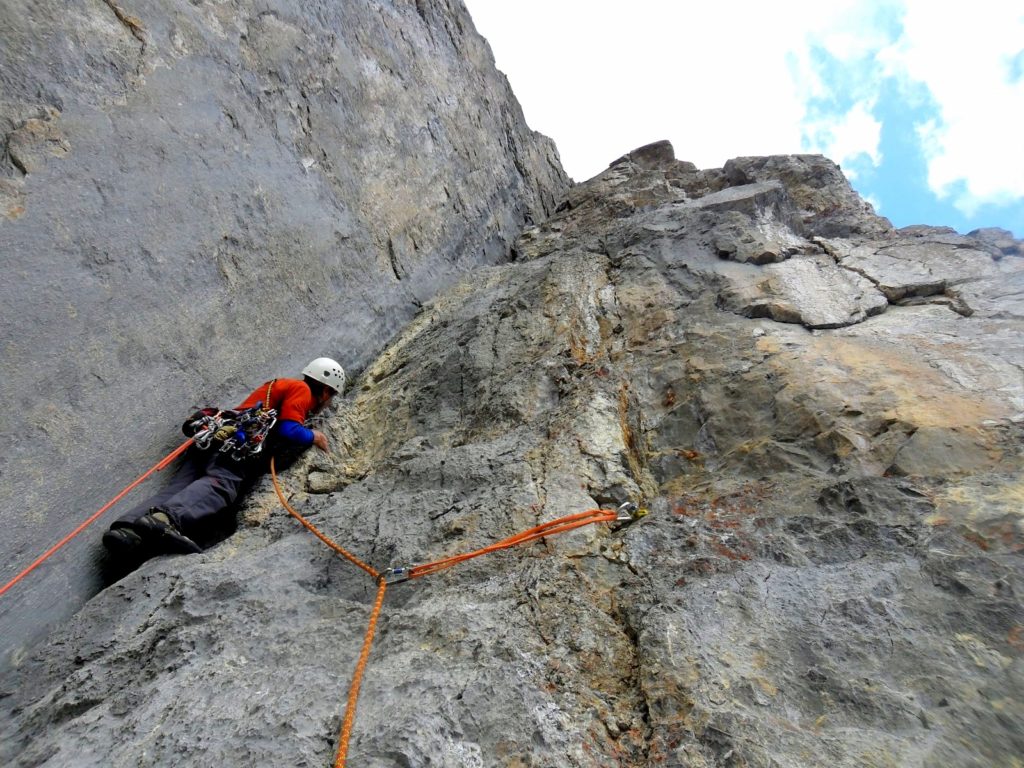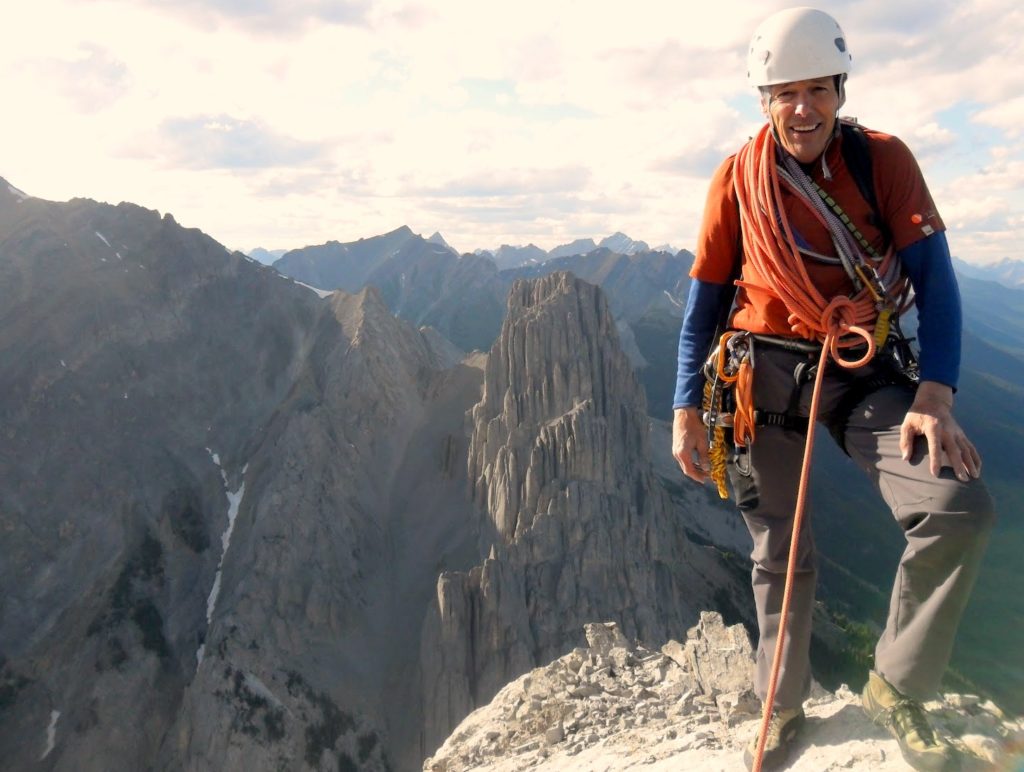A Day Climbing in the Mountains with Legend Tim Auger
On his classic Banff National Park route: Homage to the Spider

At 5 a.m. I sat on my pack at the end of my driveway. It was Aug. 5, 2011 in Canmore. Before I could sip my coffee, Tim Auger pulled up, right on time. “Brandon, I think I’m a little late,” he said. “But that’s OK. It’s early enough.” As we drove west, I asked Tim whether he’d really climbed each of the ten buttresses on Mount Rundle. He looked at the mountain, light orange in the morning sun. “I have heard that, too, but nope, not a chance,” he said. And then he grinned and raised his eyebrows.
When Tim was thirteen, his mother, a librarian, lent him The White Spider, Heinrich Harrer’s book on the Eigerwand. “It was the only book she ever thought to bring home, though she didn’t know its significance. I think she may have regretted it later,” Tim said.
“The mountain settings and inspiration drew me along a course I never wanted to deviate from.” In 1966, at age twenty, he aided the first ascent of University Wall on the Squamish Chief with Dan Tate, Hamish Mutch and Glenn Woodsworth. The 300-meter vertical-to-overhanging route was then the hardest of its kind in Canada. A year later, Tim landed a coveted trail-crew job in the Rockies. From 1969 to 1973, he spent the off-season in Yosemite. There, in 1972 with Warren Harding and Galen Rowell, he made the first winter ascent of Mount Whitney’s Keeler Needle.
He and I were now on our way to a route he’d established on Mount Louis and named Homage to the Spider, in honor of Walter Perren, “the Spider of Zermatt.” As we hiked up the trail, clouds of frozen air pressed against the lodgepole pines. “Kevin McLane asked me to describe Mount Louis once,” Tim said. “I told him: Put your hands together as if you were praying, with your thumb tucked close. Your fingers match the vertical columns of Mount Louis beautifully.” He spoke as if he were in a lecture hall, timing his words between breaths. “You don’t climb to beat your chest,” he said. “You climb to climb.”
At a stream crossing, Tim placed a soda can under a piece of moss to keep it cold—the same place he used for his many ascents of the Kain Route. Valley mist lifted to reveal dark cumulus. “No big deal,” Tim said. “We can always bail.” When I offered to lead the crux, Tim said, “Nonsense, I want to see if I still have what it takes.” Five meters above his last nut, he turned to point where the easier original route went.
Then he started up the direct variation instead: a clean, smooth, ninety-degree corner that he’d been too afraid to lead on the first ascent. Now, he seemed so excited that he nearly forgot to clip the pitons. At sixty-five, he moved with the passion of a young man, plugging cams into tiny limestone cracks, his fingers clinging to small holds. From the next belay, he looked down at me. The clouds vanished into blue sky, and the sun silhouetted the summit. “I guess I still have it!” he said.

We stopped to rest on a giant ledge. Tim leaned on his pack, his vein-knotted arms draped over his knees. I asked about Walter Perren. Tim said he’d revered him ever since he first found Walter’s fabled 1952 variation to the Kain Route: a magic line of hidden, three-finger holds, much more climbable than all the rock around it. “I realized then that Walter was a genius.” After moving from Zermatt to Ban in 1950, Walter became the leader of Canada’s National Parks Alpine Specialists.
He led the first helicopter-assisted rescue in the Canadian Rockies in 1966, using cables and ropes to haul Brian Greenwood and Charlie Locke off the East Face of Mount Babel. Walter’s variation was not far from where we sat. “His leather boots biting the tiny stipple and fingers set just right in the flaring crack,” Tim said, “Walter must have been in Valhalla.”
Tim never got a chance to meet Walter, who died in 1967. But he liked the idea of memorializing him with a new line. “Walter was the father of mountain rescue in the Canadian Rockies; his mountain craft was one I admired, or as I like to call it, pay homage.” Tim ended up working for Parks Canada for about 30 years himself, using the same rescue systems that Walter introduced.

“Fine day, eh Brandon?” Tim said, when we reached the summit’s steel cross. A golden panorama of mountains glowed and faded in the summer twilight. Mount Assiniboine flashed above a line of snowy peaks. I soaked up the last heat of the sun. Tim talked on his cell phone to his wife: “Can you hear me? We are on top, and we’re on our way.”
Back at the stream, he pulled the soda out from under the frosty moss. We shared it until the can was dry. I wrote in my journal, One of my finest days in the hills. A year later, Tim called to say that he might have one of my carabiners. I hadn’t noticed one missing, but since he insisted, I drove to his house. He was waiting at the end of his driveway. “OK, come in for a coffee. I have more stories to tell you.”
Tim died on Aug. 9, 2018, in Banff at age 72. A celebration of life was held at Mount Norquay with hundreds of climbers who came from around the world.
Story of University Wall
A version of this story first appeared in Alpinist 42 in a piece called Homage, edited by Katie Ives and written by Brandon Pullan.


